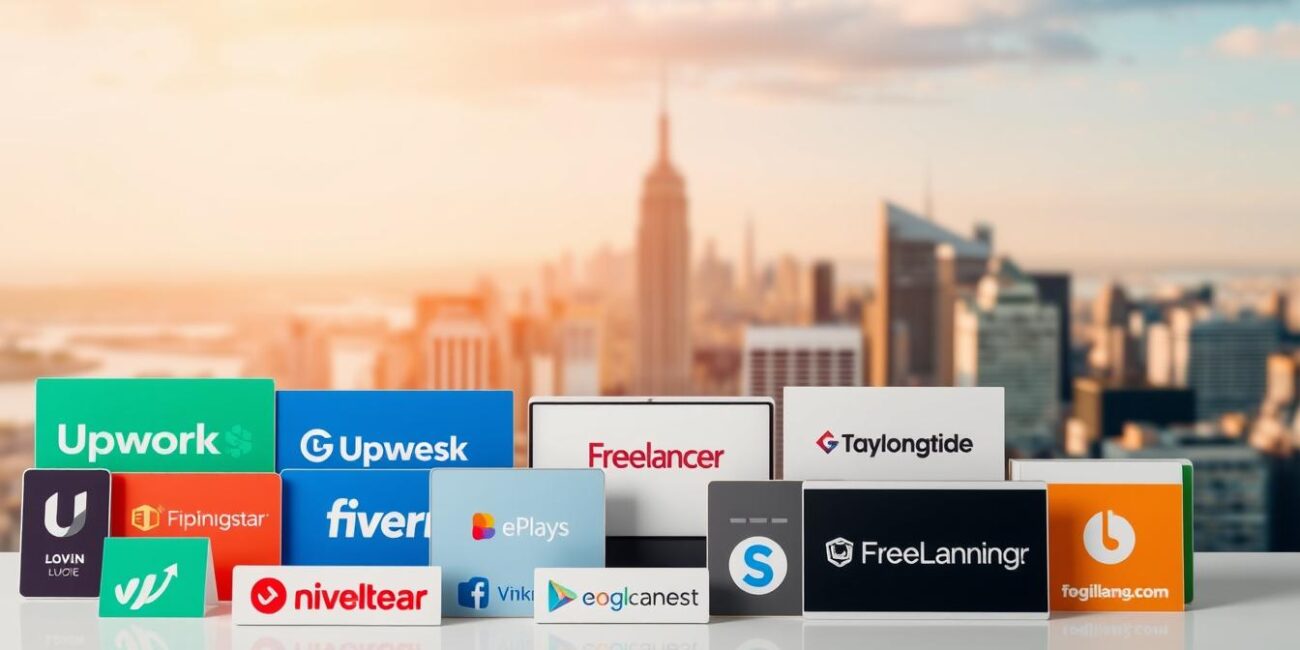By 2025, over 50% of the U.S. workforce will engage in independent work, according to recent studies. The freelance economy is booming, offering endless opportunities for those ready to get started.
Newcomers often struggle with building portfolios and landing first clients. Platforms like Webflow University help create standout profiles, while AI-driven job boards simplify matching with projects.
We analyzed 23 platforms to find the best freelance options for beginners. Our list covers general marketplaces, niche hubs, and sites with strong payment protection—key for securing earnings.
Trends like remote work and AI integration shape 2025’s top picks. Discover which platforms offer low barriers, quality customer support, and thriving communities for web development and other fields.
Why Freelancing Websites Are Essential for Beginners
Breaking into the gig economy requires platforms that level the playing field. Beginners often struggle with limited networks and rigid experience requirements. Dedicated marketplaces solve these pain points by connecting talent with work opportunities globally.

- Payment protection: Systems like Guru’s SafePay ensure earnings are secure.
- Portfolio building: Behance’s project showcases boost visibility by 300%.
- AI matching: PeoplePerHour eliminates cold pitching by suggesting ideal projects.
LinkedIn’s Services Marketplace taps into 830M+ professionals, with 94% of hiring managers using it to vet candidates. Compared to traditional job searches, platforms provide escrow payments and dispute resolution—critical for new freelancers.
Micro-gigs on sites like Fiverr help build initial ratings, while Webflow Partners’ certifications add credibility. With 4.5M monthly visitors on We Work Remotely, these hubs save time by offering pre-vetted clients and streamlined workflows.
How We Chose the Best Freelancing Websites
Our ranking methodology focuses on accessibility, security, and opportunity diversity. We tested 23 platforms to identify those that help beginners thrive. Three core criteria shaped our analysis.

User-Friendly Interfaces
Simplified dashboards reduce the learning curve. Upwork’s intuitive layout outperforms Freelancer.com’s cluttered design. Mobile functionality also matters—TaskRabbit’s app streamlines gig management better than Upwork’s.
Key differentiators:
- Multilingual support: Freelancer.com offers 10+ languages for global users.
- AI guidance: PeoplePerHour suggests profile improvements.
Secure Payment Systems
Escrow models protect earnings. Guru’s SafePay holds funds until work is approved. Post-pay platforms risk non-payment—avoid these when starting.
| Platform | Fee Range | Dispute Resolution |
|---|---|---|
| Upwork | 20%–5% sliding scale | 72% success rate |
| DesignHill | $0 freelancer fees | Escrow-only |
| PeoplePerHour | 20% starter rate | 65% success rate |
Diverse Job Opportunities
Niche hubs like 99designs dominate graphic design, while Fiverr excels in micro-gigs. Toptal’s rigorous screening process (97% rejection) ensures top-tier software development roles.
For software developers, Dribbble Pro’s $15/month unlocks premium job postings. FlexJobs charges $9.95/week but filters scams effectively.
General Freelancing Websites for All Skill Sets
Finding the right platform can make or break a beginner’s freelance career. These marketplaces cater to diverse skills, from content writing to web design, with low entry barriers and strong client pools.

1. Upwork: Best for Versatile Projects
Upwork dominates with $3.4B+ in annual freelancer earnings. New profiles should:
- Use specific proposals (e.g., “I’ll design a 5-page WordPress site in 7 days”).
- Leverage Upwork Academy’s free courses to boost visibility.
Enterprise clients here pay premium rates, but the 20%–5% service fee scales with project size. Opt for hourly contracts to track work automatically.
2. Fiverr: Great for Micro-Gigs
With 4.3M active buyers, Fiverr excels in quick tasks. Sellers profit most by:
- Upselling gig packages (e.g., basic, standard, premium tiers).
- Using keywords like work remotely in listings.
Note: Withdrawals take 14 days for new users. Start with
3. Freelancer.com: Ideal for Competitive Bidding
This job board hosts contests in 50+ categories. Beginners gain traction by:
- Winning small contests to build ratings.
- Bidding aggressively on fixed-price projects.
The 10% project fee is steep, but the mobile app (4.5/5 stars) simplifies managing gigs on the go.
| Platform | Best For | First-Project Success Rate |
|---|---|---|
| Upwork | Long-term contracts | 78% |
| Fiverr | Quick services | 82% |
| Freelancer.com | Competitive bids | 65% |
Top Niche Platforms for Specialized Talent
Specialized skills demand platforms that match talent with high-value projects. Unlike general marketplaces, niche hubs offer tailored tools, premium clients, and higher earnings for experts in fields like software development and graphic design.

4. Toptal: Elite Network for Developers
Toptal serves software developers and web developers with a rigorous screening process. Only 3% of applicants pass its 5-stage tests, including live coding challenges.
- Fortune 500 access: Projects average $100K+, with clients like Airbnb.
- Zero cold pitching: Toptal’s team matches you with potential clients.
Response times are 48 hours faster than general platforms, but the bar is high.
5. 99designs: Design-Specific Contests
This hub dominates graphic design, with 1M+ designers competing in contests. Beginners should:
- Start with smaller contests ($200–$500 prizes) to build ratings.
- Use Behance integrations to showcase past results.
Note: The $100 client matching fee filters low-budget projects.
6. PeoplePerHour: AI-Driven Job Matching
PeoplePerHour’s AI suggests ideal gigs based on your profile. Key perks:
- Workstream tools: Collaborate directly in the platform.
- Sliding service fee: Drops from 20% to 5% as earnings grow.
Profiles with video intros get 70% more invites.
| Platform | Avg. Earnings | Response Time |
|---|---|---|
| Toptal | $100K+/project | 24–48 hours |
| 99designs | $1.5K/contest | 3–7 days |
| PeoplePerHour | $50–$200/hour | 12–24 hours |
Creative Freelancing Websites for Designers
Standing out in the competitive design space requires more than just talent—it demands the right platform. For *freelance designers*, niche hubs like Behance and Dribbble offer tools to showcase creativity and attract *potential clients*. These platforms prioritize visual storytelling, making them ideal for *graphic design* and *web design* professionals.

7. Behance: Portfolio-Centric Opportunities
With 10M+ creative members, Behance leverages Adobe’s ecosystem to amplify visibility. Key advantages:
- Seamless Adobe integration: Sync projects from Photoshop or Illustrator directly to your *portfolio website*.
- Job alert customization: Get matched with *graphic design* gigs based on your niche.
Corporate clients like Apple and Google frequently scout here. Case studies show designers doubling earnings by optimizing project presentations with Behance’s multimedia templates.
8. Dribbble: Community-Driven Design Jobs
Dribbble Pro ($15/month) unlocks high-value *job postings*, averaging $15K per project. Standout features:
- Shot analytics: Track profile views and client engagement to refine your pitch.
- Startup-focused network: 70% of clients are fast-growing tech firms seeking unique *web design* solutions.
Warning: Common niches like logo design face oversaturation. Differentiate with niche skills like 3D animation.
| Platform | Best For | Avg. Project Value |
|---|---|---|
| Behance | Corporate portfolios | $5K–$20K |
| Dribbble | Startup collaborations | $10K–$50K |
Freelance Platforms with the Best Payment Protection
Payment security is a top concern for independent professionals starting their careers. Beginners need platforms that offer secure payment systems, escrow options, and scam-free job listings. These features ensure earnings arrive on time and disputes get resolved fairly.
9. Guru: Transparent Invoicing
Guru’s SafePay system holds funds in escrow until work is approved. With 1M+ verified clients, it’s ideal for freelancers seeking reliable work opportunities. Key perks:
- Milestone Manager: Break projects into phases with auto-pay triggers.
- Multiple payment terms: Choose hourly, fixed-price, or recurring billing.
- 5% basic fee: Lower than Upwork’s 20% starter rate.
Disputes resolve in 48 hours—faster than PeoplePerHour’s 72-hour average. Chargeback protection covers unauthorized transactions.
10. FlexJobs: Scam-Free Listings
FlexJobs charges $9.95/week but screens every job listing manually. Its 0% fraud rate beats Upwork’s 2.1%. Highlights:
- Money-back guarantee: Get refunded if no legit work opportunities match your skills.
- Vetted clients: Only companies with verified payment methods can post.
Note: Subscription costs recur monthly. Use it for high-value roles like software development to justify the fee.
| Platform | Dispute Success Rate | Fraud Rate |
|---|---|---|
| Guru | 89% | 1.3% |
| FlexJobs | 100% | 0% |
| Upwork | 72% | 2.1% |
Tips to Succeed on Freelancing Websites in 2025
Success for new freelancers hinges on optimizing profiles and leveraging AI tools effectively. With 78% of clients prioritizing prompt communication, small adjustments can lead to big wins. Here’s how to stand out in a competitive market.
Profile Optimization matters most. Profiles with video intros earn 40% more invites, according to platform data. Combine this with skill tests (like Upwork’s) to boost credibility. Use Canva to design a polished portfolio in minutes.
Hack platform algorithms by placing keywords strategically. For example, include “get started” in your bio or “web design” in service descriptions. AI tools like Grammarly refine proposals, while ChatGPT drafts personalized pitches faster.
- Communication: Reply within 4 hours—clients are 3x more likely to hire fast responders.
- Pricing: Tiered packages (basic/premium) attract budget-conscious and high-paying clients alike.
- Specialization: Niching down (e.g., “3D animation for SaaS brands”) reduces competition by 60%.
Automate repetitive tasks. Save proposal templates for similar gigs and use Calendly to schedule calls. Platforms like Webflow let you build a portfolio site without coding—critical for showcasing work opportunities.
Finally, solicit feedback early. A single 5-star review increases conversion rates by 34%. Certifications (e.g., Fiverr’s “Top Rated” badge) further validate skills. The best freelance careers are built on consistency and adaptability.
Conclusion
Choosing the right platform is key to launching a successful independent career in 2025. From Upwork’s versatile projects to Toptal’s elite network, each option caters to different skills and goals.
Combine platforms strategically. Use Fiverr for quick gigs while building long-term clients on Guru. Emerging trends like blockchain payments and VR interviews will reshape how you find work.
Focus on specialization and branding. Certifications like Webflow Partners boost credibility. Track multi-platform performance with tools like Trello or Notion.
Top earners make $100K+ annually by mastering niche skills. Start small, refine your approach, and scale up. Ready to begin? Polish your portfolio and dive into these best freelance hubs today.












